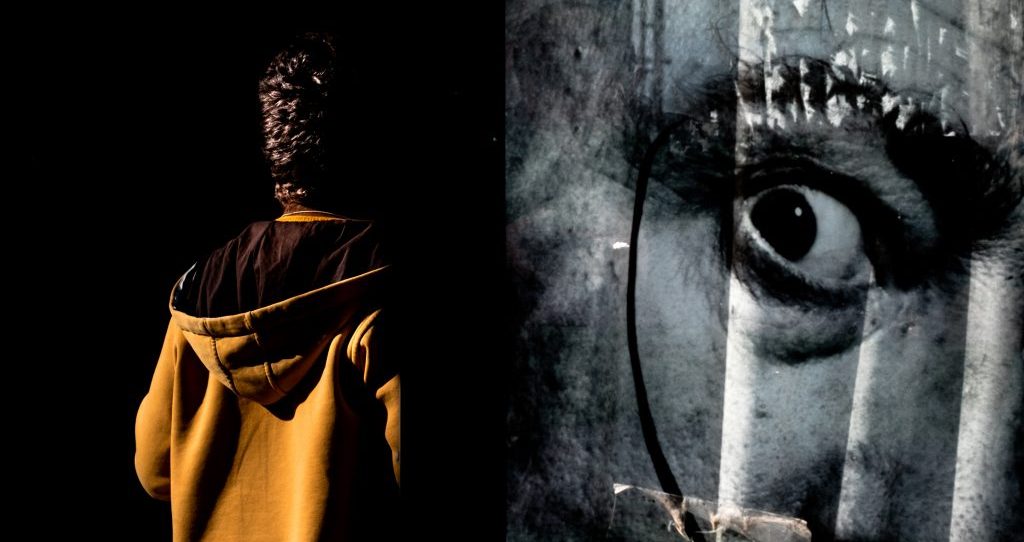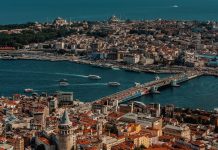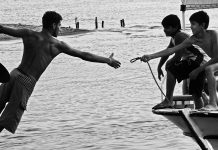“I like to use stains that define the elements they belong to in a powerfuly way. A photograph can suddenly be in your zoom, even if you do not think about it. You should try to get close enough to the subject and take photographs of that moment in many angles.” – İlker Karaman
Can you please tell us about yourself?
I was born in Giresun in September 1990. I am the elder of two children. My childhood was in Samsun, as my father was employed there as a teacher. I always think that it was a chance for me to grow up in Samsun; because it was a place with the facilities of a big city and the sincerity of a small town. Then I came to Ankara in 2008 for university education. I graduated from Bilkent University, Department of Electrical and Electronics Engineering in 2013. I currently work as an electronics design engineer in a leading technology company in Ankara. I have been involved in photography in my spare time. I take great pleasure in watching, producing, sharing, evaluating photographs.

How did your photography story begin?
I have always had a visual quest in my life. I had it in my spirit to observe, question and find the beauty. I think the story about photography begins with the first moment you get interested in photography. When I had not yet photographed, I was turning the pages of the magazines about the photographs, looked at them, spent time with them and examined them. I have started to take photographs with my mobile phone during my high school years. I was taking photos of my friends, nature and the places I visited. In 2012, I have purchased a DSLR camera. After I graduated from University, I have spent more time with photography and I realized that I had some improvements in my photography skills. The nice words, comments and likes I have received have always motivated me for better and so I improved myself. About photography, I feel like that I have a chest deep down inside me and I still have not opened it. I do not know whether it will be opened one day or not.
It is obvious that each photographer has a style. What makes your photographs ILKER KARAMAN’s photographs?
World photography has an ongoing accumulation since past. Nowadays, with mobile phones and cameras becoming more accessible, this accumulation has improved more. For this reason, I think that many types of photography have been examined. I do not think that I have my own style when I think of all the treasures of international photography, but I feel like I have similar styles with some photographers. My approach to photography shapes the areas, concepts, and photographs I am interested in. In this sense, perhaps it will be easier for me to tell you the areas I am interested in photography and what I look for in photography. I have a formal approach to photography, and I take great pleasure in using the geometric items, colors, light and shadow in photography. I want to show my audience what they cannot see in their daily life and to surprise them. In some photographs, I try to have a surreal attitude.

What is the most important thing while taking photographs? What do you do catch the frames you imagine of?
When taking photographs, I focus to create the most homogeneous and balanced element placements. While using plain as a method, I also consider it very important that the elements in my photographs are clean and they are placed before a background. I like to use stains (such as shadows and silhouettes …) in my photographs which strongly describe the elements they belong to. A photograph can suddenly be in your zoom, even if you do not think about it. You should try to get close enough to the subject and take photographs of that moment in many angles. But most of the time, as mentioned in this question, the photograph is in your mind and you wander around to find it. Yes, there are so many photographs I have in my mind that I have not yet taken, and sometimes when I go out to the street I specifically search for those photographs. It is very important that you are in the right place at the right time to capture the photograph you think of. Subject of a photograph is created in a space and it has a background It may be a good start for you to look for a place that will provide you the space and background for the photograph, so you can capture what you want. You should also know aspects such as the light in the photograph, the time of day you can reach at this light, the weather conditions for choosing the best time to capture.
What do you think about the development of photography in Turkey?
Considering the photographs I have watched and evaluated, I feel that photography has developed in Turkey. In terms of accelerating this development, I think that creative works should be rewarded and encouraged more instead of repetitive works. In world photography, photography editors and photography critics play an important role and determine the current course of photography. I see in our country that we need the photography editors and critics who closely follow the world photography. I believe that educational and encouraging approaches are needed for young people interested in photography. More specifically, it might be a sensible attempt to create a community that will inform the world about our work we do in our country and to establish a community of street photographers. I believe that a courageous and more creative generation of photographers will advance the photography in our country.

You have a style that is unique to you in the art of photography. Your composition is dominated by color, contrast and light. Will you have any future work to reveal the integrity in the future? Maybe an Exhibition?
I receive various requests about this. The audience who look at my photography through social media and other Internet contents want to see the printed versions of my photographs. I have audience who think that there are profound differences between looking at a photograph on Internet through a monitor and looking at a printed photograph, and I agree with them on this. But I am forced to postpone my projects on exhibitions and book, because of the financial problems I have and because of lack of support.
There is a device that stops the moment while observing the life. This has a magical meaning for those who take and like photographs. How does it make you feel?
The magic of taking photograph of an event that would happen once in a lifetime is something very different. Moment is above all the rules in photography and it is very important. If your technique is wrong or problematic, and even if you cannot adjust the light, you will catch a moment and that specific moment will cover all technical problems with its value. Sometimes you feel the weight of the moment on your finger when you press the shutter button. Another magical thing is in your feelings and excitement when you find that special photograph you have been searching for. At that moment sometimes one can jump up in the sky like a child.

The most important rule in photography is irregularity. This is a discourse that is being established. What do you think about the independent and free characteristic of photography?
I think there are some rules to cerate an impressive photograph. These rules are shaped by experiments and observations, including human likes and human visual perceptions. Besides, I think that geometry and proportions have a power on all visual works, not only in photography, and their rules are still not discovered. While I take my photographs, I also research the rules of geometry and proportions on images. By saying that the most important rule in photography is irregularity, I have a two sided approach. First of all, any photograph where all rules are applied in a perfect way causes a doubt of reality among the audience. This doubt sometimes covers the audience’s admiration. In other words, we can say that little irregularities strengthen the perception of reality and increase the impact of photography to a certain extent. Secondly, the rules become ordinary by time in photography after a while and they lead to repetitions. The works created by applying the same rules begin to have the similar settings and this may ebcome boring by time. Ignoring some rules intentionally brings out new patterns and this creates diversity and innovation in the works. Photography and art should be open and courageous about these issues, and sometimes our creativity is generated not by applying some rules.
Light is the building block of photography and it is a blessing. Generation of photography is completely dependent on the power of light. How would you comment on this from your own perspective?
Yes, light is one of yje building blocks of photography. It is irrevocable for me. I sometimes take the diffusion of light on the street as my subject. Even the fragmental diffusion of light has a great value for photography. As Magnum photographer Trent Parke said, “Light transforms the ordinary into a magical one.” A street photographer must be constantly aware of daylight. The places enlightened by light in photograph have lighter shades. Our eyes watch the lighter shades better than the dark areas in a photograph. If you place your subject in a place illuminated with light covered by lighter shades, the attention of the audience will increase.

Art is something that sometimes reveals the annoying but also shapes it according to its own aesthetic. How does art and photography combine at this point?
This is a very good question, art is the creativity that criticizes the moment of reality and shocks the society with that criticism. Here, the criticism of reality may sometimes be annoying as you said and therefore it may not be easily acceoted within the society. One of the reasons of existence of art is to bring together this annoyance with aesthetics and to generate an admissibility from that blend and create a critical impact on audience. Jacob AueSobol is one of names I can provide as an example in this subject with his works that contain aesthetic and annoying together in a photograph. His work is extraordinary, but he has always kept interest in his works with an aesthetical expression. We can also see this aesthetic and critical language in Magnum photographer Thomas Dworzak’s war photographs. In 2000, he has expressed his criticism of war in storytelling by applying the rules of visual aesthetics, using geometry, colors, triangular element distribution and light, which he used in photographing a wounded Chechen warrior in 2000. In the same way, when taking the pictures of bullet and cannon holes on a wall, he also reveals the reality of the destruction created by the war, even though it is an aesthetic expression with the pattern formed on the wall. There are many things that bother people around the world, and they are often the subject of photography. Applying the visual composition rules of the photography during the narration of these subjects increases the visual effect of the aesthetics and the photograph itself.
Are there any people involved in photography and art you follow? How do they effect your perspective on art?
There are too many photographers I am impressed by and who make me think. Alex Webb has a huge influence on me with the way he uses light, geometry, element distributions and colors. The second name is Trent Parke, and I really care about Trent Parke’s photographs regarding the light usage. Josef Koudelka is on the third rank for me and I think Koudelka’s photographs contain very important photography lessons in the use of geometry. Other important names of photography who have an impact on me are Saul Leiter, William Egglestone, Marc Riboud, David Alan Harvey. I also try to follow the work of photographers such as ArekRataj, MatteoSigolo, SasikumarRamachandran, TavepongPratoomwong, SwapnilJedhe, VineetVohra, Fabian Schreyer, YassineAlaouiIsmaili, NavinVitsa, Ash Nolo and Dirty Harry who take photographs actively abroad.

Today photography brings money and majority of these people enjoy following the path they want. What is your approach to photography from this sense?
People have to live in a way that makes them happy. I care more about the mental contributions of photography to human life. Probably most of them are benefits that could not be purchased. Creation of art provides benefits such as a psychological relief on the artist, a little distance from the stress of everyday life. The search for photography involves the pursuit of beauty that surround us and the effort to transform them into a visual documentation. This effort later turns into a habit in our everyday lives and always leads us to see the beauty and the good. The creativity that is used during photography improves our mind. I want to be independent when taking photographs and live these feelings to the full. If earning money from photography would cause me to give up such feelings and contributions of photography, I cannot accept that. But my photography can be a source of income if it generates a resource for my photography career in a way not interfering with my passion as long as it increases my creativity.





















